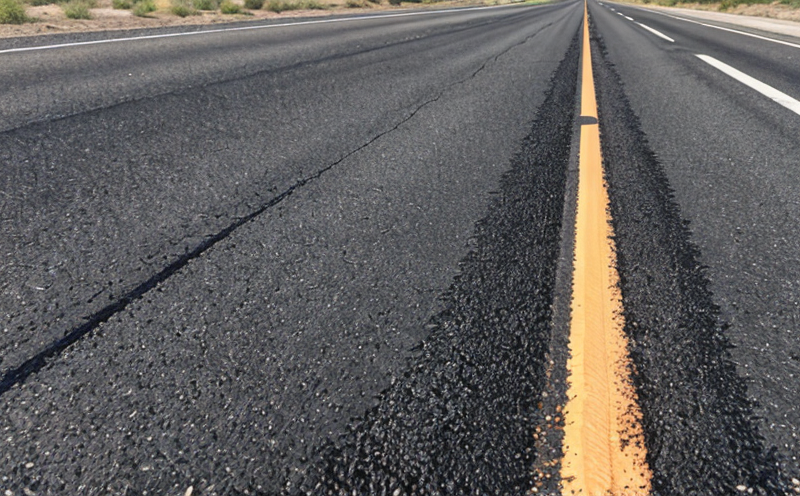ISO 13473 Pavement Macrotexture Monitoring
The ISO 13473 standard is a cornerstone in pavement macrotexture monitoring, providing a robust framework for assessing the surface texture of pavements. This standard focuses on ensuring that the surface roughness meets specific requirements to enhance safety and durability. The test parameters and specimen preparation are critical steps in this process, ensuring accurate and reliable results.
The primary objective of ISO 13473 is to measure macrotexture, which refers to the largest scale surface characteristics visible to the naked eye or with low magnification. This measurement is essential for assessing friction properties that affect vehicle-pavement interaction. The standard outlines detailed procedures to prepare specimens and conduct tests under controlled conditions.
One of the critical aspects of this service involves ensuring that the test specimen accurately represents the pavement surface in terms of macrotexture. Preparing the specimen requires precise cutting techniques, maintaining the integrity of the surface texture. After preparation, the specimen is subjected to a series of measurements using specialized equipment designed to comply with ISO 13473.
The testing process involves several stages. Initially, the surface is cleaned and prepared for measurement. The macrotexture index (MTI) is then calculated based on the measured values. MTI provides a quantitative measure of the pavement's roughness, which is crucial for evaluating safety and performance. Compliance with ISO 13473 ensures that the results are consistent and comparable across different locations and over time.
The use of this standard in real-world applications highlights its importance in ensuring safe road conditions. For instance, it helps identify areas where surface texture may be compromised due to wear or maintenance issues. This information is vital for proactive maintenance strategies, enhancing both safety and longevity of pavements.
Another key aspect of ISO 13473 involves the use of advanced instrumentation. Equipment such as profilometers and laser scanners are employed to capture detailed surface profiles. These tools provide precise measurements that contribute to accurate MTI calculations. The data collected during these tests is invaluable for R&D engineers in developing new materials and techniques aimed at improving pavement durability.
Compliance with ISO 13473 also supports quality assurance programs by providing a standardized method for evaluating pavement macrotexture. This ensures consistency in testing across different projects, which is essential for maintaining high standards of construction and maintenance practices. The use of this standard fosters trust among stakeholders, including regulatory bodies, contractors, and the general public.
For quality managers and compliance officers, adherence to ISO 13473 offers a clear path to meeting regulatory requirements while enhancing overall pavement performance. By following the prescribed procedures, they can ensure that their projects comply with international standards, thereby contributing to safer road networks.
In summary, ISO 13473 Pavement Macrotexture Monitoring is a vital service for ensuring safe and durable pavements. It involves precise specimen preparation, advanced instrumentation, and standardized testing protocols to provide reliable data on macrotexture indices. This service supports quality assurance programs and enhances safety by identifying areas that require maintenance or improvement.
Applied Standards
The ISO 13473 standard is widely recognized in the field of pavement engineering, providing a comprehensive approach to measuring pavement macrotexture. It complements other international standards such as ASTM E608 and EN 13592, which also address aspects of surface texture assessment.
- ISO 13473: Focuses on the measurement of macrotexture using profilometric techniques.
- ASTM E608: Provides methods for measuring skid resistance and related parameters, which are closely linked to pavement macrotexture.
- EN 13592: Offers guidance on the use of laser scanning for road surface texture measurement, ensuring consistency with ISO standards.
The integration of these standards ensures that testing methods are consistent and reliable across various environments. This harmonization is crucial for maintaining high-quality pavement surfaces globally.
Quality and Reliability Assurance
Ensuring the quality and reliability of ISO 13473 Pavement Macrotexture Monitoring involves several key practices that are integral to our service. The first step is meticulous specimen preparation, which must be done under controlled conditions to maintain the integrity of the surface texture.
- Specimen Preparation: Specimens are cut from the pavement using precision tools, ensuring that they accurately represent the original surface characteristics.
- Instrumentation Calibration: All testing equipment is calibrated regularly to ensure accuracy and consistency in measurements.
- Data Validation: Multiple tests are conducted on each specimen to validate results and eliminate variability.
The use of advanced instrumentation, such as profilometers and laser scanners, further enhances the reliability of our testing. These tools provide precise data that contribute to accurate MTI calculations. Regular calibration and validation ensure that all measurements align with international standards.
Our quality assurance practices extend beyond technical specifications. We employ experienced engineers who are trained in adhering to ISO 13473 requirements, ensuring consistent application of the standard across all projects. This commitment to excellence is reflected in our consistently high-quality results and reliable data.
Environmental and Sustainability Contributions
The use of ISO 13473 Pavement Macrotexture Monitoring contributes significantly to environmental sustainability by promoting safer, more durable pavements. By ensuring that the macrotexture meets specific requirements, this service helps reduce accidents and improves fuel efficiency, contributing to lower greenhouse gas emissions.
- Enhanced Safety: Properly textured surfaces enhance vehicle-pavement interaction, reducing skidding risks and improving overall safety.
- Fuel Efficiency: Sufficient macrotexture can improve traction, leading to reduced fuel consumption and lower emissions.
- Durability: Well-textured pavements last longer, requiring fewer maintenance interventions over time, which is beneficial for both the environment and economic sustainability.
The standard also supports sustainable construction practices by encouraging the use of eco-friendly materials that meet international quality standards. This approach not only enhances pavement performance but also promotes responsible resource management.
Our service plays a vital role in advancing sustainability goals through rigorous testing and compliance with ISO 13473. By ensuring that pavements are constructed and maintained to high macrotexture standards, we contribute to safer, more sustainable transportation networks globally.





